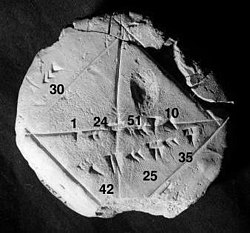
Back Numeriese analise AF Numerische Mathematik ALS Analís numerica AN تحليل عددي Arabic সাংখ্যিক বিশ্লেষণ AS Analís numbéricu AST Ədədi analiz AZ Һанлы ысулдар BA Лікавыя метады BE Лікавы аналіз BE-X-OLD

Numerical analysis studies different algorithms to get approximations for problems of mathematical analysis. Approximations are used for the following reasons:
- There are no known ways to solve a problem using calculus. Examples for such problems are the Navier–Stokes equations[2][3][4][5] or the Three-body problem
- There is a way to solve a problem using calculus. Getting an exact solution is impractical though, because it requires a long time, or many resources. An example for this is calculating power series.
One of the earliest known uses of numerical analysis is a Babylonian clay tablet, which approximates the square root of 2. In a unit square, the diagonal has this length. Being able to compute the sides of a triangle is extremely important, for instance, in carpentry and construction.[6]
Numerical analysis continues this long tradition of practical mathematical calculations. Much like the Babylonian approximation of , modern numerical analysis does not seek exact answers, because exact answers are often impossible to obtain in practice. Instead, much of numerical analysis is concerned with obtaining approximate solutions while maintaining reasonable bounds on errors.
Numerical analysis naturally finds applications in all fields of engineering and the physical sciences,[7] but in the 21st century, the life sciences and even the arts have adopted elements of scientific computations. Ordinary differential equations appear in star movement; optimization occurs in portfolio management; numerical linear algebra is important for data analysis;[8][9][10] stochastic differential equations[11][12][13][14][15] and Markov chains[16] are essential in simulating living cells for medicine and biology.[17]
Computers greatly helped this task. Before there were computers, numerical methods often depended on hand interpolation in large printed tables. Since the mid 20th century, computers calculate the required functions instead.[18] These same interpolation formulas nevertheless continue to be used as part of the software algorithms for solving differential equations.[19][20][21]
- ↑ "Photograph, illustration, and description of the root(2) tablet from the Yale Babylonian Collection". Archived from the original on 2012-08-13. Retrieved 2012-03-25.
- ↑ Constantin, P., & Foias, C. (1988). Navier-stokes equations. University of Chicago Press.
- ↑ Temam, R. (2001). Navier-Stokes equations: theory and numerical analysis (Vol. 343). American Mathematical Society.
- ↑ Foias, C., Manley, O., Rosa, R., & Temam, R. (2001). Navier-Stokes equations and turbulence (Vol. 83). Cambridge University Press.
- ↑ Girault, V., & Raviart, P. A. (2012). Finite element methods for Navier-Stokes equations: theory and algorithms (Vol. 5). Springer Science & Business Media.
- ↑ The New Zealand Qualification authority specifically mentions this skill in document 13004 version 2, dated 17 October 2003 titled CARPENTRY THEORY: Demonstrate knowledge of setting out a building
- ↑ Garcia, A. L. (2000). Numerical methods for physics. Englewood Cliffs, NJ: Prentice Hall.
- ↑ Demmel, J. W. (1997). Applied numerical linear algebra. SIAM.
- ↑ Ciarlet, P. G., Miara, B., & Thomas, J. M. (1989). Introduction to numerical linear algebra and optimization. Cambridge University Press.
- ↑ Trefethen, Lloyd; Bau III, David (1997). Numerical Linear Algebra (1st ed.). Philadelphia: SIAM.
- ↑ Kloeden, P. E., & Platen, E. (2013). Numerical solution of stochastic differential equations (Vol. 23). Springer Science & Business Media.
- ↑ Oksendal, B. (2013). Stochastic differential equations: an introduction with applications. Springer Science & Business Media.
- ↑ Mao, X., & Yuan, C. (2006). Stochastic differential equations with Markovian switching. Imperial College Press.
- ↑ Mao, X. (2007). Stochastic differential equations and applications. Elsevier.
- ↑ Platen, E. (1999). An introduction to numerical methods for stochastic differential equations. Acta Numerica, 8, 197-246.
- ↑ Behrends, E. (2000). Introduction to Markov chains (Vol. 228). Braunschweig/Wiesbaden: Vieweg.
- ↑ Tass, P. A. (2007). Phase resetting in medicine and biology: stochastic modelling and data analysis. Springer Science & Business Media.
- ↑ Brezinski, C., & Wuytack, L. (2012). Numerical analysis: Historical developments in the 20th century. Elsevier.
- ↑ Iserles, A. (2009). A first course in the numerical analysis of differential equations. Cambridge University Press.
- ↑ Ames, W. F. (2014). Numerical methods for partial differential equations. Academic Press.
- ↑ M. Nakao, M. Plum, Y. Watanabe (2019) Numerical Verification Methods and Computer-Assisted Proofs for Partial Differential Equations (Springer Series in Computational Mathematics).

